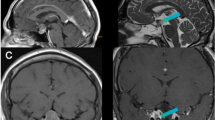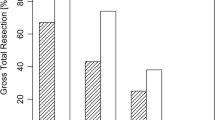Abstract
Purpose
To review the utility of intraoperative imaging in facilitating maximal resection of non-functioning pituitary adenomas (NFAs).
Methods
We performed an exhaustive MEDLINE search, which yielded 5598 articles. Upon careful review of these studies, 31 were pertinent to the issue of interest.
Results
Nine studies examined whether intraoperative MRI (iMRI) findings correlated with the presence of residual tumor on MRI taken 3 months after surgical resection. All studies using iMRI of >0.15T showed a ≥90 % concordance between iMRI and 3-month post-operative MRI findings. 24 studies (22 iMRI and 2 intraoperative CT) examined whether intraoperative imaging improved the surgeon’s ability to achieve a more complete resection. The resections were carried out under microscopic magnification in 17 studies and under endoscopic visualization in 7 studies. All studies support the value of intraoperative imaging in this regard, with improved resection in 15–83 % of patients. Two studies examined whether iMRI (≥0.3T) improved visualization of residual NFA when compared to endoscopic visualization. Both studies demonstrated the value of iMRI in this regard, particularly when the tumor is located lateral of the sella, in the cavernous sinus, and in the suprasellar space.
Conclusion
The currently available literature supports the utility of intraoperative imaging in facilitating increased NFA resection, without compromising safety.

Similar content being viewed by others
References
Roelfsema F, Biermasz NR, Pereira AM (2012) Clinical factors involved in the recurrence of pituitary adenomas after surgical remission: a structured review and meta-analysis. Pituitary 15(1):71–83
Fox WC, Wawrzyniak S, Chandler WF (2008) Intraoperative acquisition of three-dimensional imaging for frameless stereotactic guidance during transsphenoidal pituitary surgery using the Arcadis Orbic System. J Neurosurg 108(4):746–750
Yamasaki T et al (1996) Intraoperative monitoring with pulse Doppler ultrasonography in transsphenoidal surgery: technique application. Neurosurgery 38(1):95–97 (discussion 97–98)
Ram Z et al (1995) Intraoperative ultrasound-directed resection of pituitary tumors. J Neurosurg 83(2):225–230
Doppman JL et al (1994) Intraoperative US of the pituitary gland. Work. in progress. Radiology 192(1):111–115
Arita K et al (1998) Trans-sellar color Doppler ultrasonography during transsphenoidal surgery. Neurosurgery 42(1):81–85 (discussion 86)
Lee CC et al (2011) Volumetric measurement for comparison of the accuracy between intraoperative CT and postoperative MR imaging in pituitary adenoma surgery. AJNR Am J Neuroradiol 32(8):1539–1544
Mori R et al (2013) Initial experience of real-time intraoperative C-arm computed-tomography-guided navigation surgery for pituitary tumors. World Neurosurg 79(2):319–326
Berkmann S et al (2012) Intraoperative MRI and endocrinological outcome of transsphenoidal surgery for non-functioning pituitary adenoma. Acta Neurochir Wien 154(4):639–647
Berkmann S et al (2014) Follow-up and long-term outcome of nonfunctioning pituitary adenoma operated by transsphenoidal surgery with intraoperative high-field magnetic resonance imaging. Acta Neurochir Wien 156(12):2233–2243 (discussion 2243)
Kim EH, Oh MC, Kim SH (2013) Application of low-field intraoperative magnetic resonance imaging in transsphenoidal surgery for pituitary adenomas: technical points to improve the visibility of the tumor resection margin. Acta Neurochir Wien 155(3):485–493
Hlavica M et al (2013) Impact of ultra-low-field intraoperative magnetic resonance imaging on extent of resection and frequency of tumor recurrence in 104 surgically treated nonfunctioning pituitary adenomas. World Neurosurg 79(1):99–109
Vitaz TW, Inkabi KE, Carrubba CJ (2011) Intraoperative MRI for transphenoidal procedures: short-term outcome for 100 consecutive cases. Clin Neurol Neurosurg 113(9):731–735
Ramm-Pettersen J et al (2011) Intra-operative MRI facilitates tumour resection during trans-sphenoidal surgery for pituitary adenomas. Acta Neurochir Wien 153(7):1367–1373
Wu JS et al (2009) Transsphenoidal pituitary macroadenomas resection guided by PoleStar N20 low-field intraoperative magnetic resonance imaging: comparison with early postoperative high-field magnetic resonance imaging. Neurosurgery 65(1):63–70 (discussion 70–71)
Gerlach R et al (2008) Feasibility of Polestar N20, an ultra-low-field intraoperative magnetic resonance imaging system in resection control of pituitary macroadenomas: lessons learned from the first 40 cases. Neurosurgery 63(2):272–284 (discussion 284–285)
Nimsky C et al (2006) Intraoperative high-field magnetic resonance imaging in transsphenoidal surgery of hormonally inactive pituitary macroadenomas. Neurosurgery 59(1):105–114 (discussion 105–114)
Theodosopoulos PV et al (2010) Maximizing the extent of tumor resection during transsphenoidal surgery for pituitary macroadenomas: Can endoscopy replace imtraoperative imaging? J Neurosurg 112:736–743
Berkmann S et al (2014) Intraoperative high-field MRI for transsphenoidal reoperations of nonfunctioning pituitary adenoma. J Neurosurg 121(5):1166–1175
Paterno’ V, Fahlbusch R (2014) High-Field iMRI in transsphenoidal pituitary adenoma surgery with special respect to typical localization of residual tumor. Acta Neurochir Wien 156(3):463–474 (discussion 474)
Coburger J et al (2014) Determining the utility of intraoperative magnetic resonance imaging for transsphenoidal surgery: a retrospective study. J Neurosurg 120(2):346–356
Tabakow P et al (2012) Surgical treatment of pituitary adenomas using low-field intraoperative magnetic resonance imaging. Adv Clin Exp Med 21(4):495–503
Bellut D et al (2012) Impact of intraoperative MRI-guided transsphenoidal surgery on endocrine function and hormone substitution therapy in patients with pituitary adenoma. Swiss Med Wkly 142:w13699
Baumann F, Schmid C, Bernays RL (2010) Intraoperative magnetic resonance imaging-guided transsphenoidal surgery for giant pituitary adenomas. Neurosurg Rev 33(1):83–90
Anand VK et al (2006) Endoscopic transphenoidal pituitary surgery with real-time intraoperative magnetic resonance imaging. Am J Rhinol 20(4):401–405
Schwartz TH, Stieg PE, Anand VK (2006) Endoscopic transsphenoidal pituitary surgery with intraoperative magnetic resonance imaging. Neurosurgery 58(1 Suppl):ONS44–ONS51 (discussion ONS44–51)
Darakchiev BJ et al (2005) Adaptation of a standard low-field (0.3-T) system to the operating room: focus on pituitary adenomas. Neurosurg Clin N Am 16(1):155–164
Bohinski RJ et al (2001) Intraoperative magnetic resonance imaging to determine the extent of resection of pituitary macroadenomas during transphenoidal surgery. Neurosurg 49:1133–1144
Dort JC, Sutherland GR (2001) Intraoperative magnetic resonance imaging for skull base surgery. Laryngoscope 111(9):1570–1575
Fahlbusch R et al (2001) Intraoperative magnetic resonance imaging during transsphenoidal surgery. J Neurosurg 95(3):381–390
Pergolizzi RS et al (2001) Intra-operative MR guidance during trans-sphenoidal pituitary resection: preliminary results. J Magn Reson Imaging 13(1):136–141
Berkmann S et al (2011) Intraoperative magnetic resonance imaging and early prognosis for vision after transsphenoidal surgery for sellar lesions. J Neurosurg 115(3):518–527
Acknowledgments
Kunal Patel was a Howard Hughes Medical Institute Medical Research Fellow.
Author information
Authors and Affiliations
Corresponding author
Ethics declarations
Conflict of interest
Authors have no financial relationship with the organization that sponsored the research.
Rights and permissions
About this article
Cite this article
Patel, K.S., Yao, Y., Wang, R. et al. Intraoperative magnetic resonance imaging assessment of non-functioning pituitary adenomas during transsphenoidal surgery. Pituitary 19, 222–231 (2016). https://doi.org/10.1007/s11102-015-0679-9
Published:
Issue Date:
DOI: https://doi.org/10.1007/s11102-015-0679-9




